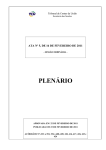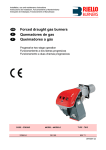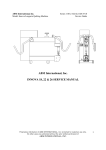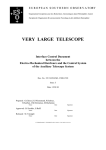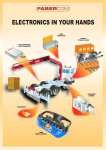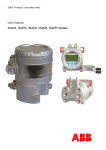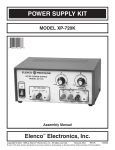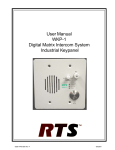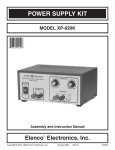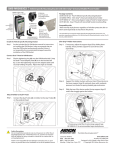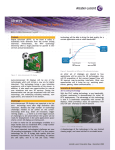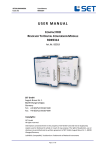Download Bravo drive
Transcript
The MiniBravo amplifier series is distributed with the CE mark, because they are in accordance with the European Directives on EMC and Low Voltage. WARNING! ELECTRICAL AND CONTROL EQUIPMENT CAN BE DANGEROUS IF HANDLED IMPROPERLY This manual describes the mechanical and electrical characterists of the MiniBravo series. It is important, that the installation procedures are only performed by qualified personnel in accordance with local safety guidelines. Whoever installs the equipment must follow all of the technical instructions printed in this manual. For more information, please contact Global Motion T echnologies technical department. All rights reserved.Reproduction in whole or in part is prohibited without prior written consent of the copyright owner. All specifications are subject to change without prior notice. Service Manual MiniBravo Ver.MB-gb-05/00 Description Index 1) Description 1.1 Introduction 1.2 Technical features 1.3 Inputs and outputs 1.4 Drive dimensions 2) Adjustments 2.1 Personalizations and settings 2.2 Solder bridges 2.3 Potentiometer adjustments 3) Diagnostic 3.1 L.E.D. indicators 4) Installation 4.1 Power supply rating 4.2 Connections 4.3 Preliminary checks 5) Commissioning 5.1 Initial start up Pag 1 2 2 3 4 5 6 7 8 9 12 15 16 6) Setting up the drive 6.1 Speed adjustment with tacho feedback 6.2 Nominal current adjustment 6.3 Peak current adjustment 6.4 Offset adjustment 6.5 Ramp time adjustment 6.6 Adjustment with armature feedback 6.7 Dynamic costant adjustment 7) Troubleshooting 17 18 19 19 20 21 23 25 8) Options 8.1 Available options 8.2 Encoder feedback 8.3 Block Diagram 26 27 31 1 Service Manual MiniBravo Description 1.1 Introduction The MiniBravo is a very small sized bi-directional drive with four quadrant function. The output power stage (mosfet) is controlled using the PWM technique with 20 Khz modulation frequency. This drive is designed for driving small Dc brushed servomotors (up to 2 Nm)where dynamic performance and fast response is required. The speed feedback may be through tachogenerator, armature feedback or encoder(option). For its supply a unique Dc source with a wide range is required. If a drive module is replaced, it is important to verify that the new drive module is calibrated as the one removed. It is also possible adapt the dynamyic costant in according with the adjustment requested. To use the various options avalaible on drive,we must open or close the solder bridges located upon the drive. Four leds on the drive describe the status of the drive. 1.2 Technical Features The MiniBravo, is a drive with a wide range of power supply. It needs a unique Dc source from 22 to 80 Vdc with a differential input reference. The enable is provided by Dc voltage between +10 Vdc/30Vdc. Service Manual MiniBravo 2 Description Technical Features The nominal and peak current can be adjusted by a resistor located on the socket. The drive dimensions are 134.5 x 81 x 27.5mm. (3.19” x 5.29” x 1.08” ). Listed below are the four sizes of the MiniBravo product line. The operating temperature is from 0 to 40 °C (32° to 104°F) and no ventilating system is required as long as the spacing between the drives allow for adequate air flow. Size I Nominal (A) 1/2 1 I Peak(A) 2 2.5 / 5 2.5 5 6 / 12 6 12 10 / 20 10 20 1.3 Inputs and Outputs The Following are descriptions of the output drive connector. 1 DriveOK NC(open collector max current 100mA) 2 Demand current 3 Common zero signal 4 Auxiliary output voltage +10 volts 5 mA max 5 Auxiliary output voltage -10 volts 5 mA max 6 Enable(+10/30 volt drive enabled ) 7 Input speed reference +(Non inverting input) 3 Service Manual MiniBravo Description 8 9 10 11 12 13 14 Input speed reference -(inverting input) Tacho input + Tacho input +AT Power supply (input positive power supply ) - AT Power supply (input negative power supply) +M Positive motor terminal - M Negative motor terminal 1.4 Drive dimensions 1.08” 5.29” 3.19” Service Manual MiniBravo 4 Adjustments 2.1 Personalizations and setting WARNING : After switching off to do the adjustments, please wait for about 30 sec before working inside the drive. If the drive isn’t adjusted with the proper servomotor, follow these procedures. Allof the personalizations are located inside of the MiniBravo . -To enter to the adjustment components and the solder bridges , unscrew (A) , and remove the cover (B). (See fig. 1) 5 Service Manual MiniBravo Adjustments All of the adjustments are located in the area behind the potentiometers .It’s there that a socket containing all of the adjustment components is located.. The socket is made by a double row of components with pitch 7.62mm/0.3” (resistors) with 9+9 ways, and 3+3 ways for components with pitch 5.08 mm/0.2” (capacitors). The resistors may be 1/4W. -Pin -Pin -Pin -Pin -Pin -Pin -Pin -Pin -Pin -Pin -Pin -Pin 1-24 2-23 3-22 4-21 5-20 6-19 7-18 8-17 9-16 10-15 11-14 12-13 (RDT) (RA) (RCA) (RIN) (RIP) (RKV) (GAIN) (RP1) (RP2) (pitch 5,08) (pitch 5,08) (pitch 5,08) (CKV) (CDER) (CDER) 2.2 Solder bridges S1 Normally open. If closed, the activation of IN protection, inhibits the output of the drive’s OK transistor. When this situation occurs the green OK LED is OFF. S2 -S4 Normally opens. (See chapter 6.5 “Ramp time adjustement”). S3 Normally closed. (See chapter 6.5 “Ramp time adjustement”). S5 -S6 Normally closed. If open, the dynamic constant CKR and RKV must be inserted on the personalization socket.(PI loop gain). S7 Normally open. If closed, enable the armature feedback (See chapter 6.6 ) Service Manual MiniBravo 6 Adjustments 2.3 Potentiometer adjustment ACC The solder bridges S2-S4 allow insertion of the acc/dec function (ramp). With this potentiometer we can adjust the slope of the ramp in acceleration and deceleration. Turning the potentiometer clockwise (cw) increases the ramp time from 0,1 to 1 Sec (with 10 V reference). It is also possible to increase more, this time by opening solder bridge S3 and inserting resistance RP 2 on the socket. (See chapter ADJUSTMENT) VEL Speed potentiometer.Turn the potentiometer clockwise (cw) to increase the maximum speed and anti-clockwise (ccw) to reduce the maximum speed. The range of the adjustment is +/-20%. BIL Offset adjustment.Adjust this potentiometer to cancel any offset in the external speed ref. signal. (Max ref. compensation +/- 200mV). KV With this adjustment we can improve the dynamic behaviour of the servomotor.With a clockwise turn (cw)we increase the gain of the PI “speed stage”, therefore, improving the response. DER Turn the potentiometer clocwise (cw)to increase the derivative effect,reducing the amount of overshoot in the system response. 7 Service Manual MiniBravo Diagnostics 3.1 LED indicators Four LEDs are available on the drive and they signify the following: -L1 (GREEN) OK Normally ON, signifying proper operation of the drive. When the LED is OFF, it indicates that at least one of the drive protection functions is active. -L2 (RED) IN Normally OFF,it is lit when it exceeds the programmed value. (Reversible alarm) -L3 (RED) ST Normally OFF,it represents overheating of the heatsink drive. This fault provokes the activation and memorization of the alarm. To reset it is necessary that you turn off the power supply, wait until the heatsink temperature is lower, and then re-start the power supply. -L4 (RED) OC Normally OFF. May come ON,because of a short circuit between motor terminals or come to ground.It can’t be reset and the fault provokes the memorization of the alarm. Switch off the system,eliminate the cause and then re-start the power supply. Service Manual MiniBravo 8 Installation 4.1 Power supply rating WARNING:Use the following scheme and equation shown below to calculate the power supply rating. The drive doesn’t need auxiliary voltage ,all of the voltages requested come from an internal flyback. A single or three phase transformer may be able to supply one or more drives. Transformer The drive has the internal zero signal connected with the negative (power), consequently Don’t use auto transformers. The factory reccomends using transformers with the secondary winding that must be delta/triangle-connected. VOLTAGE: The primary voltage depends on the available net voltage. The secondary voltage will be calculated according to the motor’s characteristics and according to the voltage drive range. The value will be: V1(ac) = Vmotor 0,9 x 1,36 9 Service Manual MiniBravo Installation The factory suggests keeping a margin by choosing AC voltage to avoid too high voltage during the deceleration phases of the motor;this value is 60 VDC (44 VAC) Max value is 80Vdc and minimum value is 22 Vdc. The power rating of the transformer is calculated in accordance with the total power (SUM) of all single motors used: P(VA)=Power absorbed servomotor 1+power abs. servomotor 2+....etc. Notice:If multiaxis application is required,the transformer power rating may be reduced by 30 % respecting the original equation. REF. the filter capacitor - the factory reccomends one with a working voltage of at least 100 Vdc. The appropriate value may be find with the follow equation: C (mF) = P (VA) trasfo. x 2000 V2 V2 = DC voltage on the terminals capacitor without load. The capacitor serves to filter the voltage from the bridge and recover the energy during the motors deceleration phases. Service Manual MiniBravo 10 Installation Power supply rating (continued) A fuse should be fitted into each of the transformer’s primary and secondary windings,F1 and F2. These fuses may be replaced with a magneto-termic switch with the same value. The F1 fuse mounted on the primary protects the transformer. This fuse must be the “slow” type. The F2 fuse mounted on the secondary also protects the transformer and that fuse must be the “slow” type. 11 F 1° = P (VA) trasnf. V (primary) ac x 1,1 F2 = 2A = 5A =10A = 20A X MB X MB X MB X MB 1/2 2,5/5 6/12 10/20 Service Manual MiniBravo Installation 4.2 Connections Below is information about appropriate wiring;thereby, improving noise reduction and safety. -Always use shielded cables to connect the ref signals and the tacho signal. -Signal cables and power cables must be segregated and wired through different trunking. -Reference the section of the cable, the factory suggests: 1.5 mm/square up to size 6/12 for power cables. 2.5 mm/square up to size 10/20 for power cables. Connections (example) A A) This drawing shows an example of connecting the speed reference using the internal voltage of the drive. The speed potentiometer must have a value between 5k and 47 kOhm. The tacho screen must be connected to 0 S of the drive with only one cable. That cable connects the tacho screen to the isolated bar in the electrical box. Service Manual MiniBravo 12 Installation Connections (continued) B) This drawing shows an example with an application to connect the differential speed ref from CNC. The connections are the same as explained in A. B C) Applying a resistive load a current limitation comes from the drive,when contact 1 is closed. If we insert a potentiometer with a value of 470 Kohm connected as rheostat,the current may be reduced from 95% to zero. C 13 Service Manual MiniBravo Installation Power connection D) The outputs +M and -M may be connected directly to the motor terminals. When a motor has an inductance value less than 0,7 - 0,8 mH, a choke is required,connect in series,so the form factor is improved. This avoids overheating the servomotor. D Service Manual MiniBravo 14 Installation 4.3 Preliminary checks -Check that all of the terminals are properly fixed in according with the motor polarity and tacho polarity,so the motor runs clockwise (cw) with positive speed reference. -Check that the correct values of components have been used.Also check that the components are correctly fitted. (From tachogenerator feedback,from armature feedback, from encoder feedback or in current mode). 15 Service Manual MiniBravo Commissioning 5.1 Initial start up 1)First, it is important that the motor’s shaft is free from the load and be ready to stop the main power supply quickly, if necessary. It is also important that the motor is fixed to a proper stand. Please ensure that the ref signal is zero (0). 2)Apply power to the drive. In normal situations,after a delay of about 1 second,the green OK LED will come on. The motor must be still. (If the LED doesn’t come on ,please check the proper value of the power supply with a multimeter). WARNING: If the motor is driven by C.N.C., use the ref in manual mode with the servo error disabled. (Space loop disabled). 3)Enable the drive; PWM ON active. A good rule is to provide the enable after the power supply . Check that the motor is stationary or turns slowly due to a signal offset,this means that the tacho polarity is correct. If the motor rotates in an opposite direction to the expected one,switch off and reverse the motor and tachogenerator connections . WARNING: After switching off,wait about 15 seconds before re-applying power to the drive in order to avoid problems. 4)Increase the speed reference up to one(1) volt and check the sense of the motor’s rotation. (If the motor rotates in the opposite direction of the expected one,reverse the motor and tachogenerator connections or reverse the speed reference connections). Service Manual MiniBravo 16 Commissioning 5)Apply the load to the motor’s shaft,and insert the space loop on the C.N.C. If the system’s behaviour is the same as before and the servo error alarm doesn’t appear,the system has been properly regulated. 6)Now, leave the system powered up in typical working conditions. Check that no protection occurs (red LEDs all OFF),and the green drive LED is on. 6.1 Speed adjustment with tachogenerator feedback The drives are provided with the RDT resistance mounted on board.The drive is adjusted for 3000 rpm with a tachometer costant 10v/1000 rpm referred to 10V reference. If you desire to change this resistor, just open the cover of the drive, then change the value of the resistor. To calculate it,please use the following equation: RDT (Kohm) = Kdt x n x 9,7 _ 8 1000 x Vref 17 Service Manual MiniBravo Setting up the drive Where: Rdt is the value expressed in Kohm with a power rating of 1/8 or 1/4w. Kdt is the tachogenerator costant n° is the max speed express ed in RPM. Vref is the max voltage reference expressed in Volts. When the RDT resistor is mounted adjust the fine speed by using the VEL potentiometer located in front of the drive. Clockwise...............Increases the speed. CounterClockwise..Decreases the speed. The range adjustments are +/20%. 6.2 Nominal current adjustment The drive is pre-set for nominal sized current, (RIN free). To reduce this value in accordance with the servomotor’s characteristics it is necessary to mount a resistance RIN in the socket (see fig. 1). A table with the correspondence current/resistor is reported below. current express in (A). RIN Value in Kohm * 18 8.2 4.7 3.3 2.2 1.8 1.2 1 0.82 MCS 1/2 MB 1 0.9 0.8 0.7 0.65 0.6 0.55 0.5 0.45 0.4 MCS MB 2.5/5 2.5 2.3 2.1 1.9 1.8 1.5 1.4 1.2 1.1 1 MCS MB 6/12 6 5.5 5.1 4.6 4.2 3.7 3.4 2.9 2.7 2.4 MCS MB 10/20 10 9.3 8.5 7.7 7.1 6.2 5.8 5 4.6 4.2 Service Manual MiniBravo 18 Setting up the drive 6.3 Peak current adjustment To reduce the value of peak current,it’s necessary to mount RIP on the socket (see fig. 1) located inside of the drive. Below is a table with the proper values: current express in (A). RIP Value inKohm * 220 150 82 68 56 47 39 MB 1/2 (A) MCS 2 1.9 1.8 1.65 1.6 MB 2.5/5 (A) MCS 5 4.6 4.5 4.1 3.9 MB 6/12 (A) MCS 12 11.1 10.7 9.7 9.3 8.9 MCS MB 10/20 (A) 20 18 17.4 15.5 15 33 22 1.5 1.4 1.35 1.3 1 3.7 3.5 3.4 3.1 2.6 8.4 8 7.5 6 14.4 13.7 13 12.1 10 6.4 Offset adjustment The drive is provided with the offset adjustment made by tachogenerator feedback. If any further adjustment is required,please use the Bil potentiometer . (The compensation is +/- 200mV in respect to the input reference). With zero input reference adjust the potentiometer until the motor is perfectly still. 19 Service Manual MiniBravo Setting up the drive 6.5 Ramp time adjustment This function is enabled by solder bridges S2 , S4 (closed). It allows adjustment of the ramp slope during both acceleration and deceleration. Adjusting the ACC potentiomenter, located in front of the drive, clockwise (cw)increases the ramp time between 0,1 and 1S (It corresponds to 10V reference). (See note 1) FUNCTION Ramp disabled RANGE 0 sec. NOTE Standard solder bridges Ramp enable 0,1 - 1 Adjustable by ACC pot Ramp enable RP2 res sec. Adjustable by ACC pot It is also possible to modify the “range of the ramp” opening solder bridge S3 and mounting a resistor in the socket between pin 9 and 16 (Rp2 res. ). The proper value is reported on the table below. (See note 2 ) RP2 Res. TIME Service Manual 680K 0,2 -2,6 s. 820K 0,3 - 3,2s. MiniBravo 1Mohm 0,4 - 3,9s. 20 Setting up the drive 6.6 Armature feedback adjustment Armature feedback mode may be used as speed feedback when a tachogenerator is not fitted to the motor. Speed control is then less precise(the regulation range is 1/20, and below this value the torque is reduced). This funciton will be enabled by solder bridge (closed) JP7and mounting in the socket RA and RCA resistors. RA resistor It will be mounted on the socket “ pin 2-23” to adapt the system to the voltage motor costant. To calculate it use this equation: RA(k ohm) = 166 x Vref E - 1,4 Vref WHERE: E = n x Ke 1000 Ke= Servomotor BEMF at 1000 rpm Vref= Max voltage reference. n= max speed express in rpm. Example:Servomotor with Ke=20 n=3000 RPM Vref=10 E = 3000 x 20 = 60 1000 RA(kohm) = 166 x 10 = 36 Kohm 60 - 1,4 x10 Use the nearest commercial value, 33 Kohm. 21 Service Manual MiniBravo Setting up the drive RCA resistor It will be mounted on the socket “pin 3-22”, to compensate for the voltage drop due to the motor’s internal resistance. To calculate it,use this equation: RCA (k ohm) = 0,5 x n Ke Vref Ipk Ri WHERE: n= max. speed expressed in rpm. Ri=Total motor resistance with brushes. Ipk =Peak current, (size)of the drive. Ke=Sevomotor BEMF at 1000 rpm. Vref= Max voltage reference. Example: Drive 10/20 A , Ri=2.5 ohm RCA (kohm) = 0,5 x 4000 x 50 =200 Kohm 10 x 20 x 2.5 Use a resistor of 56 Kohm or the higher value. If,after this procedure the motor is unstable increase the value by using the next (higher) commercial value avalaible. Service Manual MiniBravo 22 Setting up the drive 6.7 Dynamic costant adjustment Usually,these calibrationsare made by the factory and don’t need adjusting. Only re-tuning by KV and DER potentiometer is required. If high inertia loads are present (ratio 3:1 between load and motor),it is necessary to modify the proportional gain by “KV potentiometer” and increase the value of derivative by ”DER potentiometer”. The adjustment procedure must take place with the load connected to the motor. Connect a function generator with square wave (0,5 Hz +/ - 1V) to the input speed reference terminals. Connect the probe of the memory oscilloscope “channel A” to the tachogenerator signal. (The ground of the probe must be connected to the GND of the drive). Adjust counter-clockwise(ccw) the “DER potentiometer”. Be sure that the load’s motion doesn’t create a safety risk. Apply power to the drive and start it. The load will begin to move alternatively;if possible increase the generator amplitude up to +/-2V. Check the signals in the oscilloscope;the waveforms should be as shown on the right. 23 Service Manual MiniBravo Setting up the drive Insufficient proportional gain. Increase the gain turning clokwise (cw) using “ K V potentiometer” until achiving a situation as shown on the left. To reduce the overshoot adjust clockwise (cw) using “Der potentiometer”, until achieving a situation as shown on the left. Caution: Don’t exaggerate with the gain: it can cause unnecessary motor heating. It’s possible to increase the velocity loop derivative constant by inserting a capacitor CDER on the personalization adjustment. See chapter 2.1 Service Manual MiniBravo 24 Fault finding 7.1 Troubleshooting 1) Applying power supply the green OK LED is unlit. -Power supply voltage is out of range; Check the voltage value by instrument . 2) Green OK LED on with drive on and motor not moving.. -Check the input signal. 3) When the drive is turned on the Green OK LED goes off and the red O.C. LED comes on.. - Look for a short circuit between the motor terminals or the motor winding is connected to ground. Switch off the system and check by instrument the insulation . 4) During the motor’s deceleration phase,the green OK LED switch goes off -The voltage has exceeded the max value accepted. -Check the value of the filter capacitor . -See the chapter on power supply. 5) During normal operation the S.T. red LED is on and the motor stops. -Enviroment temperature to high “more than 40 °C(0°F)” -Ventilate “ if necessary “ 25 Service Manual MiniBravo Options 8.1 Options available External choke When a motor has an inductance value less than 0,7 - 0,8 mH, it is necessary to use an external choke connected in series. Thereby improving the form factor and avoiding overheating the motor. N.B. The two cables between the drive and the choke are a source of noise,consequently they should be kept as short as possible. DESCRIPTION Encoder feedback board Single phase bridge 35A-600V Filter capacitor 10000mF/100V Filter capacitor 4700mF/100V Single phase transformer Three phase transformer E.M.C Filters etc. Service Manual MiniBravo 26 Options and accessories 8.2 Encoder feedback (option) The encoder feedback board (5.002.0) is an option of the MiniBravo drive. This card allows you to adjust the motor speed,using a signal coming from an encoder with two channels. This solution saves the use of a tachogenerator,using the same signal requested for the position control. The performanceof the drive at low speeds are improved with the high encoder resolution. It is reccomended that you use an encoder with resolution of at least 500 imp/rev. An auxiliary power supply +5 V or + 12 V is avalaible to supply the encoder. Don’t exceed the load declared. If the encoder’s absorption is unknown,please check it by a milliamperometer connected in series to +Vs. If the value is higher,please use an external power supply. FIG. 1 R S T 27 Service Manual MiniBravo Options and accessories To insert the encoder board into the MiniBravo, follow these procedures: -Take off the cover and remove the R screw. -Insert the S stand-off in the R hole. -Mount the encoder card (5.002.0) inserting the pin strip into the MiniBravo. -Now,replace the R screw and affix the card. If not specified,the MiniBravo with encoder feedback is supplied adjusted to 25Khz. Tecnical specification Encoder inputs Push-Pull ,Line-driver, Open-C. Power supply levels Max. frequency Encoder power supply From 0V to 5 min. 0V to 24V max. 200 Khz S2 Close Vs=5V Max 85 mA S2 Open Vs=12V Max.100 mA Operating temperature 0 - 40 C° Terminals description Code Description Pin out +Vs GND CHA CHB Encoder power supply +5 /12V GND Power supply Input channel A encoder Input channel B encoder Output Output Input Input Solder bridge description Code Description Standard S1 S2 S3 Insert internal res. pull-up Select value Power supply Insert internal res. pull-up Open Close Open Service Manual MiniBravo 28 Options and accessories Encoder adjustment The R10 resistor allows adjusting the speed with 10V of reference,to the preferred frequency. R10=810000 Fenc. Where Fenc. is: Fenc=Imp.g x Rpm 60 Example: N° encoder rev= 500 RPM =3000 R10=810000= 32,4Kohm 25000 Will be use 33Kohm or 27Kohm Connections The system show in FIG. 2 is a typical connection with a push pull or open collector encoder. The power supply is provided onboard by the same card. If a Line driver encoder is used, connect to input channels,only CHA and CHB positive . FIG. 2 29 Service Manual MiniBravo Options and accessories Below is an example,with push pull or open collector encoder.(Fig. 3). The encoder receives the power supply from an external source,connecting the GND of the source with GND of the board. If a Line driver encoder is used,connect to input channel only CHA and CHB positive. FIG. 3 Service Manual MiniBravo 30 Block diagram 8.3 Block diagram 31 Service Manual MiniBravo
































